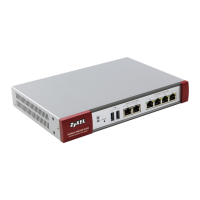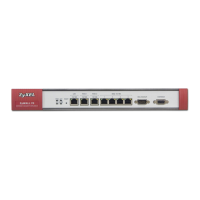Chapter 6 Monitor
USG20(W)-VPN Series User’s Guide
130
6.19.2 The Anti-Spam Status Screen
Click Monitor > UTM Statistics > Anti-Spam > Status to display the Anti-Spam Status screen.
Use the Anti-Spam Status screen to see how many e-mail sessions the anti-spam feature is
scanning and statistics for the DNSBLs.
Figure 109 Monitor > UTM Statistics > Anti-Spam > Status
The following table describes the labels in this screen.
Sender Email Address This column displays when you display the entries by Sender Email Address. This
column displays the e-mail addresses from which the USG has detected the most
spam.
Occurrence This field displays how many spam e-mails the USG detected from the sender.
Table 54 Monitor > UTM Statistics > Anti-Spam (continued)
LABEL DESCRIPTION
Table 55 Monitor > UTM Statistics > Anti-Spam > Status
LABEL DESCRIPTION
Refresh Click this button to update the information displayed on this screen.
Flush Click this button to clear the DNSBL statistics. This also clears the concurrent mail
session scanning bar’s historical high.
Concurrent Mail Session
Scanning
The darker shaded part of the bar shows how much of the USG’s total spam
checking capability is currently being used.
The lighter shaded part of the bar and the pop-up show the historical high.
The first number to the right of the bar is how many e-mail sessions the USG is
presently checking for spam. The second number is the maximum number of e-
mail sessions that the USG can check at once. An e-mail session is when an e-
mail client and e-mail server (or two e-mail servers) connect through the USG.
Mail Scan Statistics These are the statistics for the service the USG uses. These statistics are for when
the USG actually queries the service servers.
# This is the entry’s index number in the list.
Service This displays the name of the service.
Total Queries This is the total number of queries the USG has sent to this service.

